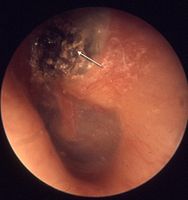
Photo from wikipedia
Abstract Background: Mastoid development, tympanic sinus depth, and residual disease after surgery for congenital cholesteatoma are probably related, but these relationships have not been examined in detail. Aims/objectives: This study… Click to show full abstract
Abstract Background: Mastoid development, tympanic sinus depth, and residual disease after surgery for congenital cholesteatoma are probably related, but these relationships have not been examined in detail. Aims/objectives: This study aimed to clarify the relationships between the abovementioned factors. Materials and Methods: The subjects were 31 patients with congenital cholesteatoma (stage III or IV in Potsic’s staging system) that underwent mastoidectomy. The cross-sectional area of the mastoid air cells was measured as described previously. Tympanic sinus depth was classified into A–C using Marchioni et al.’s system. Results: Patients with deep tympanic sinuses or residual disease exhibited significantly greater mastoid air cell development. However, little residual disease was found in the mastoid air cells. Conversely, residual disease was observed more frequently in the patients with deep tympanic sinuses. Conclusions and significance: After surgery for congenital cholesteatoma, residual disease is more likely to occur in patients with marked mastoid growth, possibly because they have deep tympanic sinuses. Cases in which congenital cholesteatoma spreads to the mastoid air cells are classified as stage IV in Potsic’s system, but our findings indicate that invasion into a deep tympanic sinus is more important than invasion into the mastoid air cells.
Journal Title: Acta Oto-Laryngologica
Year Published: 2020
Link to full text (if available)
Share on Social Media: Sign Up to like & get
recommendations!